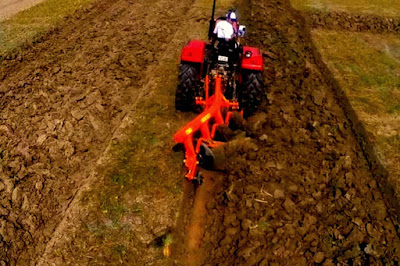Tilling the soil before planting or land preparation is a
quite expensive and critical operation for the success of the farming season.
There are numerous patterns that are used for tilling the soil. Use of Tillage
equipment depends on these different types of ploughing patterns.
The most important purpose of using various types of plough or tillage equipment is to reduce the number of turns and get the best out of the
length of tillage rounds.
Ploughing patterns are decided on various factors such as
· The use of
the implement
· Field
levels for – headland, plains
· Field
shapes – long, narrow
· Types of
Soil
Different types of ploughing patterns are mentioned below
1. Circuitous
pattern –
· This
ploughing pattern is most commonly used in Asia.
· In this
type, farmers start ploughing from the outside edge of the field, towards the
centre leaving a furrow in the middle.
· The soil
is thrown on the outside of the field. This is commonly done with disc plough,
Mouldboard plough, offset disc plough.
2. Headland
Pattern –
(i) One way –
· The
ploughing is done in tracks parallel to each other, starting at one side of the
boundary, ending at the opposite side of the field and turns made on the
headlands.
· This
pattern is generally used in large fields and done by some specific tillage
implements such as rotavators or rotary tillers, harrows and reversible MB plough.
· This is
one of the most efficient systems to plough the fields.
· The
tillage equipment should be correctly operated r set up so that it does not
leave a furrow in the fields.
(ii) Gathering –
· In this
type of pattern ploughing is started from the middle of the field and leaves a
field level.
· In this
pattern, it is essential to have the right measurement of the field for
deciding the centre point.
· If done
properly, it makes the soil smooth and ideal for planting, creating drainage
passages on the edges.
· Furrow
parts are turned towards the middle of the field.
· This
pattern of ploughing can be done with any types of ploughs.
(iii) Casting Pattern –
· This
pattern is quite the same as the gathering pattern but the ploughing is started
at the edges.
· Furrow
parts are generally turned towards the edges of the land.
· This types
of the pattern can be used with all types of ploughs.
3. Continuous
Ploughing
· This is
considered the most economical and convenient ploughing pattern for normal soil
conditions.
· In this
pattern, the headland is marked initially and the first point is established in
the third quarter of the field width from the edge.
· The other
edges are at the complete width over the field.
Farmers start ploughing between the first edge and along with the side
land.
· Farmer
continues to turn tractor left in the three quarters until the ploughing of a quarter of land width is completed on each side.
4. Round and
round ploughing
· In this
pattern the plough is used round and round of the field
· This pattern is generally used in soil conditions where the ridges and furrows
obstruct the tilling work.
· There are
two starting points in this.
(i)
Centre Starting
· A tiny
part in the middle of the field is marked and ploughed first
· And later,
the ploughing is done round this tiny spot of the field until it is completed
till the end.
· This
pattern is not very economical.
(ii)
Outer end Start
· It is
started with Tractor ploughing from the end moving on all the sides of a field
and then gradually coming from the edges to the mid of the field.
· This is
one of the conventional ploughing methods.
(iii)
One way ploughing
· This
pattern is done with a specific type of plough known as a reversible plough.
· A
reversible plough turns furrows to the right or left.
· The farmer
plough along a straight side of the field
· At the end
of the first round, the farmer turns tractor in a loop and returns through the
same furrow.
· This
pattern is most suitable for gently sloping fields.





